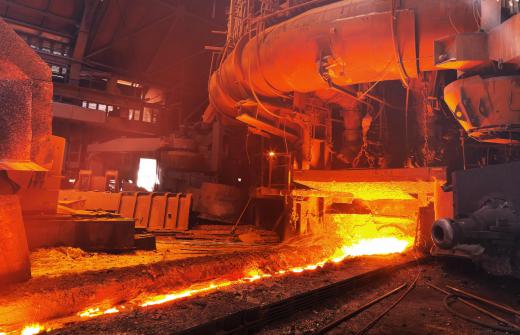At AboutMechanics, we're committed to delivering accurate, trustworthy information. Our expert-authored content is rigorously fact-checked and sourced from credible authorities. Discover how we uphold the highest standards in providing you with reliable knowledge.
What Is Nickel Smelting?
Nickel smelting is the process that nickel ore goes through to eventually remove impurities and leave just the nickel metal. While the ores can come from different stones and sources, they have two categories: lateritic, or rocks found in tropical climates and which contain nickel; and sulfidic ore, which is mined from underground. Various processes must happen to the ore, depending on the type of ore and the smelter’s preferences, for it to become nickel. Some nickel smelting processes will create slag, while others will be cleaner.
The first part of nickel smelting is getting the ores. Lateritic ores are found in tropical climates, where the nickel is deposited below the surface of the ore by weathering. This ore has a high moisture content and contains other metals, such as iron. Sulfidic ores are mined from underground, have a much lower amount of moisture, and may contain many different metals in the same ore. Regardless of which ore is chosen, the smelter can still extract nickel.

An electric furnace is then typically used to heat the nickel ore until it melts. The melting point of nickel is 2,647° Fahrenheit (1,453° Celsius), so powerful furnaces must be used. Most often, nickel smelting occurs with flash smelting, in which electricity and oxygen are combined to quickly reach the high temperature needed. Nickel ore must melt until it becomes a product known as liquid matte, which is usually around 45 percent nickel and 55 percent slag or other metals. Slag is typically removed because it can be sold to other industries and because it cannot be refined any further.
The next process in nickel smelting is refining the liquid matte, which is typically done with one of two processes. With fluid bed roasting, sulfides are added to the liquid matte and the two are roasted together, eventually leaving just the nickel metal. The other process is chloride-hydrogen reduction, in which the liquid matte is kept around 1,742° F (950° C) until a reaction occurs from the heat and the liquid matte turns into just nickel.
After the nickel smelting is complete, and the nickel has cooled, it is then used for many different purposes. Nickel is commonly used as an alloying agent with steel and other metals, because it is corrosion-resistant and has high polish, or it sold as is to other industries so they can make various products. It also is used to hydrogenate vegetable oils, along with batteries and magnets.
AS FEATURED ON:
AS FEATURED ON:











Discussion Comments
@hamje32 - I don’t think nickel smelting of coins is legal. I don’t know the rationale; it may have to do with concerns about money circulation.
Given that this is the case it would be hard to find a nickel smelter who would melt down your collection for you. Why do you want to melt them anyway?
You could always just cash them in. If these are collector’s coins, I would try to sell them to coin collectors. They will certainly give you more than the face value of the coins. You can try to sell them online too if you want.
Does anyone know if nickel smelting is legal for a nickel coin collection? I heard that the actual nickel alloys in the nickel coin are worth more than the face value of the coin.
I think it’s something like fifty percent more than what the nickel is worth, from one estimate that I’ve read. Of course I don’t know what the smelting fee would be. That would certainly cut into your profits.
I do have a large collection of nickels and so I think I could still make some money on volume. But I don’t want to even try to locate a smelter if it’s not legal.
Post your comments